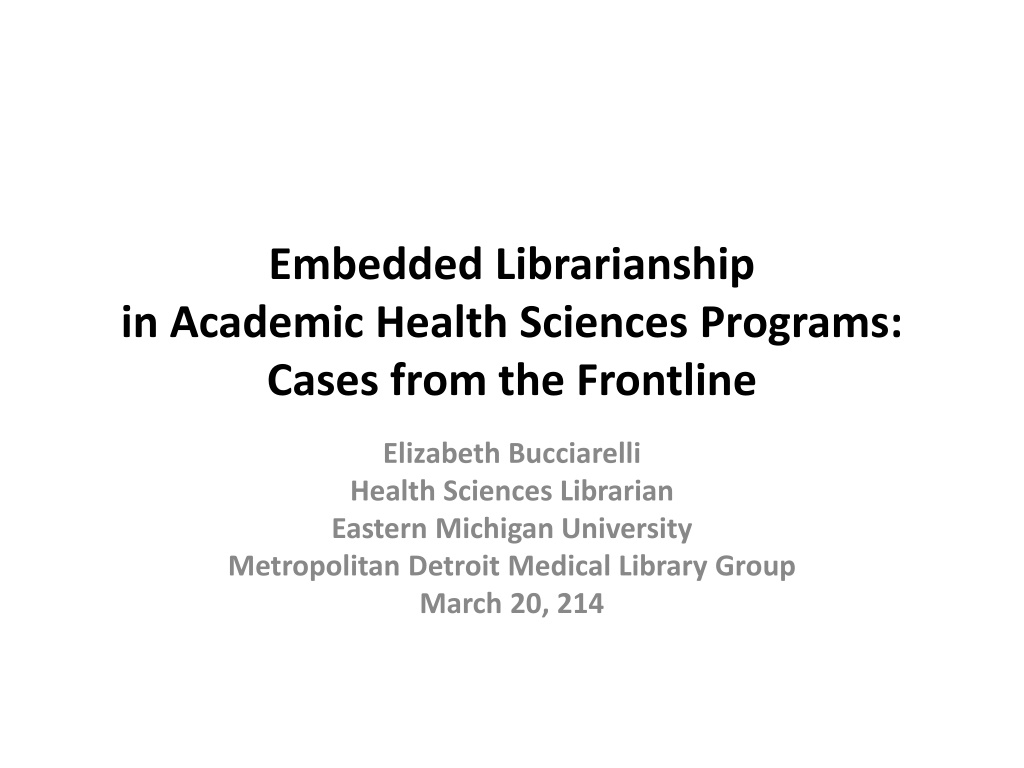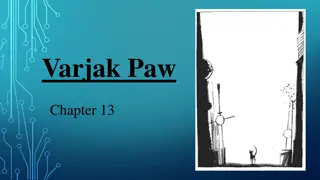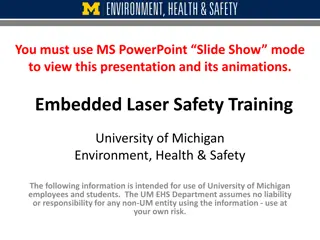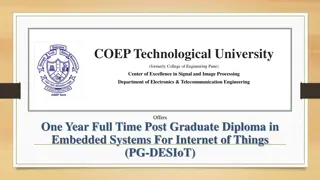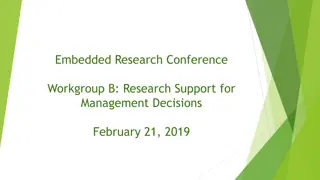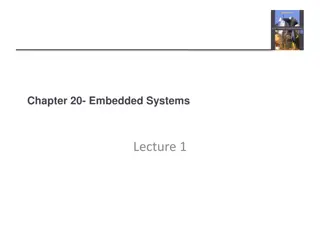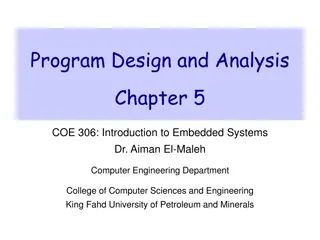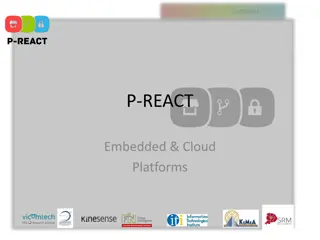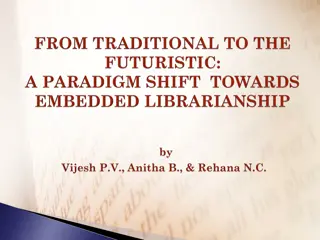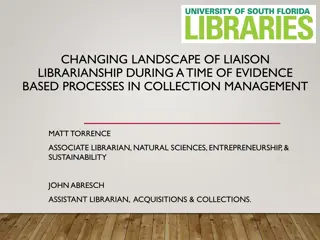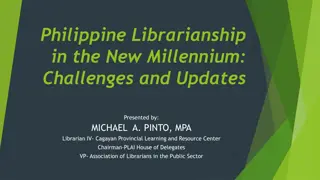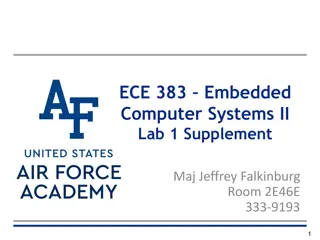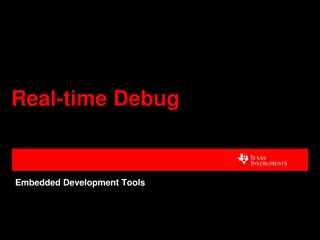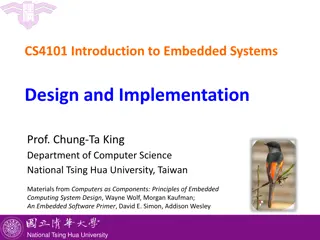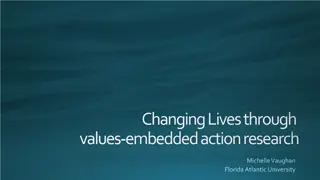Exploring Embedded Librarianship in Academic Health Sciences Programs
This content delves into the concept of embedded librarianship in academic health sciences programs, showcasing cases and insights from the frontline. It highlights the various roles and responsibilities of embedded librarians, including providing research assistance, creating tutorials, engaging with faculty and students, and integrating library services into courses. The discussion also addresses challenges with traditional one-time instruction sessions and emphasizes the importance of embedding library support throughout the learning process for more effective outcomes.
- Embedded Librarianship
- Academic Health Sciences
- Research Assistance
- Information Literacy
- Teaching Strategies
Uploaded on Sep 15, 2024 | 0 Views
Download Presentation

Please find below an Image/Link to download the presentation.
The content on the website is provided AS IS for your information and personal use only. It may not be sold, licensed, or shared on other websites without obtaining consent from the author. Download presentation by click this link. If you encounter any issues during the download, it is possible that the publisher has removed the file from their server.
E N D
Presentation Transcript
Embedded Librarianship in Academic Health Sciences Programs: Cases from the Frontline Elizabeth Bucciarelli Health Sciences Librarian Eastern Michigan University Metropolitan Detroit Medical Library Group March 20, 214
The Many Faces of the Embedded Librarian Thehomeplanet.org Aventure-journal.com whotalking.com Digital.fantast.deviantart.com Dreamstime.com Johnlund.com Moreinfo.co.nz Ebay.com
So, What Can Being an Embedded Librarian Mean? Provides online, synchronous presentations & research assistance Creates video tutorials that users can view at point-of-need Reviews research assignments Conducts office hours in an academic department Jordangadsby.com
So, What Can Being an Embedded Librarian Mean? Embeds a library link into courses as part of the course management systems Answers reference questions via email or chat Creates electronic research guides, e.g. LibGuides Attends or participates in face-to-face courses Attends rounds or clinicals w/ medical staff Informationsist hybrid role betw. librarianship, computer science, and subject scholarship; viewed as the technology expert on the team
Working Definition Librarian who is involved in teaching research instruction sessions that are: written into the program or course curriculum OR based on an agreement between the librarian and the instructor Minimum of two sessions with each group of students Tiered information is knit into each session Ultimate: librarian has access to the final learning objects
Problem, Problems, Problems, with One-Time Sessions Too much information in too short a time span Students do no retain the information Little time for hands-on portion which helps with information retention Student research skills remain at a basic level Creativemarbles.com
Problem, Problems, Problems, with One-Time Sessions Result in poor quality of research papers & projects Faculty frustrations with students level of research concepts & skills Faculty unsure which resources to direct students towards for difficult or interdisciplinary subject research Students do not become information literate, lifelong researchers & savvy information consumers Healthyplace.com
Embedded Courses Overview Number of sessions w/ Librarian Tiered Instruction Written Embedded into Curriculum Librarian & Instructor Initiated Agreement Librarian Provides 1-1 Research Asst. for Students Librarian Views End Product End Product Class or Courses Course #1-1 Course #2-1 Course #3-1 Ugrad. Nursing Course Sequence -Debates -Papers -Presenta- tions Yes Yes Yes No Master s Papers & Posters Yes Yes Yes Yes Philos. -2 OT Phil. & Research Research -3 Master s Clinical Research Admin. Proposal Develop. Research proposal No Yes Yes Yes Course - 3
Overview of Embedded Graduate Courses Number of Sessions/semester Class or Courses Length Location Clinical Res. Admin. Proposal Dev. 3 50 min #1 Library #2 Library #3 - Library Session 1 1 h Occupational Therapy Phil. 2 #1 Library #2 Library Session 2 3 h Session 1 3 h Session 2 3 h Session 3 - 2 h Occupational Therapy Research Methods 3 #1 Library #2 Library #3 - Classroom
Overview of Embedded Undergraduate Courses Number of Librarian Lead Sessions/Class Course Number Frequency Length Location Number of Course Sections /Semester Library Off campus Library Off campus Library Off campus NURS 275 1x/semester 1 1.5 h 7 NURS 372 1x/semester 1 1.5 h 2 NURS 375 1x/semester 1 3 h 7
Curriculum of Embedded Courses- Clinical Research Administration Proposal Development Session #1 Session #2 Session #3 Recognize & identify primary, secondary & tertiary research sources w/ poll Locate primary research in dissertation & theses databases Locating statistics Basic searching of GVRL, CINAHL, PubMed, & library catalog, w/ hands-on Advanced searching in using subject headings, PubMed, CINAHL, & WorldCat w/ hands-on Cited reference searching, Web of Science, Google Scholar, w/ hands-on Distinguishing characterizes of journal types Search medical ebook collection w/ hands-on Librarian research proposal consultations Identifying characteristics of a research article Librarian research proposal consultations
Curriculum of Embedded Courses- Philosophy of Occupational Therapy Session #1 Session #2 Avoiding plagiarism, w/ in- class exercise Identifying types of journals, including peer reviewed Generating topics w/ in- class group exercise Introduction to basic searching techniques w/ hands-on Discussion of popular resources (blogs, newspapers) discovery tool, general information databases, GVRL, MedlinePlus, etc. w/ hands-on Discussion of basic OT databases, CINAHL, OTDBASE, OT Search, PsycINFO, ERIC , w/ hands- on
Curriculum of Embedded Courses- Occupational Therapy Research Methods Session #1 Session #2 Session #3 Evidence-based practice information retrieval & evaluation, Cochrane Library , AHRQ, & other EBP dbs Descriptions of additional OT databases, PubMed, Sociological Abstracts Librarian consultations w/ student project groups Cited reference searching, Web of Science, Google Scholar, hands-on Advanced searching using subject headings, hands-on Locating statistics Evaluating a web site Locating & accessing print & ebooks, including WorldCat, hands-on In-class group topic-database selection exercise In-class group database exploration exercise Student project groups w/ librarian consultation
Curriculum of Embedded Courses- Undergrad Nursing Core Course Sequence NURS 275 NURS 372 NURS 375 Avoiding plagiarism, w/ in-class exercise Discussion of additional nursing databases Advanced searching using subject headings, CINAHL, PubMedhands-on Evidence-based practice information retrieval & evaluation Identifying types of journals, including peer reviewed Cited reference searching, Web of Science, Google Scholar, hands-on Evaluating web sites w/ in- class exercise Searching the EBP databases, AHRQ, NGC, Cochrane Library, w/ hands-on Introduction to basic searching techniques, w/ hands-on Locating federal & state law, legislation re: nursing; locating authoritative opinions Searching CINAHL & PubMed for EBP info Discussion of basic health & nursing databases, CINAHL, GVRL, w/ hands-on Locating & accessing print & ebooks, including WorldCat, hands-on
Embedded Research Instruction Sequence for Information Literacy Librarian In-class exercises Outside Application Time Build Relevancy Consultation
Benefits for the Student Combats the information overload that occurs with one-shot sessions; too much information to absorb in one session Need repetition of the information to retain these skills Build the foundation then, tier-in new skills Gain critical analysis skills Time to use in-class group and individual exercises to reinforce the skills just gleaned
Benefits for the Student Learn that research is not a straight line, but rather a meandering path Experience a larger picture of research as they grow from novice to skilled researchers Students demonstrate a mastery of research skills via the tiered research assignments Improves student learning outcomes
Benefits for the Student Gain confidence in their research abilities Development of the student-librarian relationship Reduces plagiarism Greater likelihood of proposal completion because the students create their proposals step-by-step along the way
Student Comments Branching off of what we ve already learned will help me to guide my research searches. Refreshing how to use databases I was already using and how to use them more effectively. I liked how there was some review information Just wish (we) could go home attempt, and return with questions. I always forget what ! and * means, so it s nice to be reminded. I did forget a few things that I learned from previous sessions I understand that it will still take practice and tie to develop this skill Bring variety, detail, & depth of info to my research papers Learn the quirks of the different databases More efficient at searching, and spend less time doing the actual research
Benefits for the Instructor Ability to point to teacher-preferred information resources; embed links to those sources in class research guides Relationship building as it is a joint-venture between librarian and instructor Improves resources cited in student projects & papers Improves quality of papers Spend less class time discussing problems with research and more time on course content
Benefits for the Instructor I do not have the expertise to assist students in understanding how to locate the most appropriate information for their reviews, develop effective search strategies, and negotiate search engines. In your involvement in the course and the project, you provide students with the tools to gather the resources they need to complete the project and answer their project clinical research questions in order to develop information fluency skills. OT Professor, Occupational Therapy Research Methods
Faculty Comment OT Professor Comment This year, students disseminated the best work I have seen in this project; the resources they gathered for their review were closely linked to their clinical research questions, they had an in-depth understanding of the resources the critical reviewed, and their analysis of findings reflected a high level of synthesis. I feel that students performance this year was, in part, due to your willingness to provide the amount and quality of support to the process they undertake to complete their work.
Benefits for the Library We re all in this together Promotes of library, EMU provides us countless number of options when it comes to researching for a paper and this all be extremely helpful Promote use of class research guides, e.g. LibGuides Promote use of subject-specific tools that students may never locate on their own
Caveats Repetition of material for the student Loss of library staff cohesion Exponential workload as classes scale out; mind the workload balance Large time commitment Require multiple conversations between librarian and instructor 1-1 group or individual sessions Revise materials frequently
References Kuan-nien, C., & Pei-chun, L. (2011). Information literacy in university library user education. Aslib Proceedings, 63(4), 399-418. doi:10.1108/00012531111148967 Cox, A. M., & Corrall, S. (2013). Evolving academic library specialties. Journal of the American Society for Information Science & Technology, 64(8), 1526-1542. doi:10.1002/asi.22847 Grabowsky, A. (2013). Information and interaction needs of distance students: Are academic libraries meeting the challenge?. Georgia Library Quarterly, 50(2), 12-18. Schulte, S. J. (2012). Embedded academic librarianship: A review of the literature. Evidence Based Library & Information Practice, 7(4), 122-138. Shumaker, D. (2009). Who let the librarians out?. Reference & User Services Quarterly, 48(3), 239-242. Retrieved from http://www.ala.org
